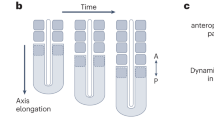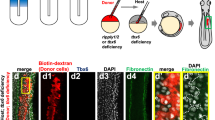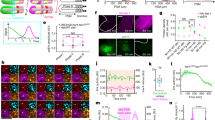Abstract
A quantitative description of the molecular networks that sustain morphogenesis is one of the main challenges of developmental biology. In particular, a molecular understanding of the segmentation of the antero-posterior axis in vertebrates has yet to be achieved. This process known as somitogenesis is believed to result from the interactions between a well-studied genetic oscillator and a less established posterior-moving determination wavefront. Here we describe a molecular model for somitogenesis that couples a moving morphogen wavefront with the somitogenetic oscillator. The wavefront is due to a switch between stable states that results from reciprocal negative feedbacks of Retinoic Acid (RA) on the activation of a kinase ErK and of ErK on RA synthesis. We suggest a molecular mechanism by which that switch can be triggered by the somitogenetic clock. The model quantitatively accounts for the shortening of the pre-somitic mesoderm (PSM) in zebrafish in response to the decrease during somitogenesis in the concentration of a morphogen (Fgf8). The generality and robustness of the model allows for its validation (or invalidation) in other model organisms.







Similar content being viewed by others
References
Cross, M.C., Hohenberg, P.C.: Pattern formation outside of equilibrium. Rev. Mod. Phys. 65, 851–1112 (1993)
Dequéant, M.-L., Pourquié, O.: Segmental patterning of the vertebrate embryonic axis. Nat. Rev. Genet. 9, 370–382 (2008). https://doi.org/10.1038/nrg2320
Cooke, J., Zeeman, E.C.: A clock and wavefront model for control of the number of repeated structures during animal morphogenesis. J. Theor. Biol. 58, 455–476 (1976). https://doi.org/10.1016/S0022-5193(76)80131-2
Kulesa, P.M., Fraser, S.E.: Cell dynamics during somite boundary formation revealed by time-lapse analysis. Science 298, 991–995 (2002). https://doi.org/10.1126/science.1075544
Delfini, M.-C., Dubrulle, J., Malapert, P., Chal, J., Pourquié, O.: Control of the segmentation process by graded MAPK/ERK activation in the chick embryo. Proc. Natl. Acad. Sci. U.S.A. 102, 11343–11348 (2005). https://doi.org/10.1073/pnas.0502933102
Durbin, L., Brennan, C., Shiomi, K., Cooke, J., Barrios, A., Shanmugalingam, S., Guthrie, B., Lindberg, R., Holder, N.: Eph signaling is required for segmentation and differentiation of the somites. Genes Dev. 12, 3096–3109 (1998). https://doi.org/10.1101/gad.12.19.3096
Pourquié, O.: Vertebrate somitogenesis. Annu. Rev. Cell Dev. Biol. 17, 311–350 (2001)
Schröter, C., Herrgen, L., Cardona, A., Brouhard, G.J., Feldman, B., Oates, A.C.: Dynamics of zebrafish somitogenesis. Dev. Dyn. 237, 545–553 (2008)
Pourquié, O.: Vertebrate segmentation: from cyclic gene networks to scoliosis. Cell 145, 650–663 (2011). https://doi.org/10.1016/j.cell.2011.05.011
Gomez, C., Ozbudak, E.M., Wunderlich, J., Baumann, D., Lewis, J., Pourquié, O.: Control of segment number in vertebrate embryos. Nature 454, 335–339 (2008). https://doi.org/10.1038/nature07020
Dubrulle, J., McGrew, M.J., Pourquié, O.: FGF signaling controls somite boundary position and regulates segmentation clock control of spatiotemporal Hox gene activation. Cell 106, 219–232 (2001)
Sawada, A., Shinya, M., Jiang, Y.J., Kawakami, A., Kuroiwa, A., Takeda, H.: Fgf/MAPK signalling is a crucial positional cue in somite boundary formation. Development. 128, 4873–4880 (2001)
Dubrulle, J., Pourquié, O.: fgf8 mRNA decay establishes a gradient that couples axial elongation to patterning in the vertebrate embryo. Nature 427, 419–422 (2004). https://doi.org/10.1038/nature02216
Diez del Corral, R., Olivera-Martinez, I., Goriely, A., Gale, E., Maden, M., Storey, K.: Opposing FGF and retinoid pathways control ventral neural pattern, neuronal differentiation, and segmentation during body axis extension. Neuron 40, 65–79 (2003)
Moreno, T.A., Kintner, C.: Regulation of segmental patterning by retinoic acid signaling during xenopus somitogenesis. Dev. Cell 6, 205–218 (2004). https://doi.org/10.1016/S1534-5807(04)00026-7
Shimozono, S., Iimura, T., Kitaguchi, T., Higashijima, S.-I., Miyawaki, A.: Visualization of an endogenous retinoic acid gradient across embryonic development. Nature 496, 363–366 (2013). https://doi.org/10.1038/nature12037
Niederreither, K., Vermot, J., Le Roux, I., Schuhbaur, B., Chambon, P., Dollé, P.: The regional pattern of retinoic acid synthesis by RALDH2 is essential for the development of posterior pharyngeal arches and the enteric nervous system. Development. 130, 2525–2534 (2003)
Kam, R.K.T., Deng, Y., Chen, Y., Zhao, H.: Retinoic acid synthesis and functions in early embryonic development. Cell Biosci. 2, 11 (2012). https://doi.org/10.1186/2045-3701-2-11
Blentic, A., Gale, E., Maden, M.: Retinoic acid signalling centres in the avian embryo identified by sites of expression of synthesising and catabolising enzymes. Dev. Dyn. 227, 114–127 (2003). https://doi.org/10.1002/dvdy.10292
Sakai, Y., Meno, C., Fujii, H., Nishino, J., Shiratori, H., Saijoh, Y., Rossant, J., Hamada, H.: The retinoic acid-inactivating enzyme CYP26 is essential for establishing an uneven distribution of retinoic acid along the anterio-posterior axis within the mouse embryo. Genes Dev. 15, 213–225 (2001)
Pownall, M.E., Isaacs, H.V.: FGF signalling in vertebrate development. Morgan & Claypool Life Sciences, San Rafael (CA) (2010)
Goldbeter, A., Gonze, D., Pourquié, O.: Sharp developmental thresholds defined through bistability by antagonistic gradients of retinoic acid and FGF signaling. Dev. Dyn. 236, 1495–1508 (2007). https://doi.org/10.1002/dvdy.21193
Hamade, A., Deries, M., Begemann, G., Bally-Cuif, L., Genêt, C., Sabatier, F., Bonnieu, A., Cousin, X.: Retinoic acid activates myogenesis in vivo through Fgf8 signalling. Dev. Biol. 289, 127–140 (2006). https://doi.org/10.1016/j.ydbio.2005.10.019
Moreno, T.A., Jappelli, R., Belmonte, J.C.I., Kintner, C.: Retinoic acid regulation of the Mesp-ripply feedback loop during vertebrate segmental patterning. Dev. Biol. 315, 317–330 (2008). https://doi.org/10.1016/j.ydbio.2007.12.038
Hayashi, S., Shimoda, T., Nakajima, M., Tsukada, Y., Sakumura, Y., Dale, J.K., Maroto, M., Kohno, K., Matsui, T., Bessho, Y.: Sprouty4, an FGF inhibitor, displays cyclic gene expression under the control of the notch segmentation clock in the mouse PSM. PLoS ONE 4, e5603 (2009). https://doi.org/10.1371/journal.pone.0005603
Sari, D.W.K., Akiyama, R., Naoki, H., Ishijima, H., Bessho, Y., Matsui, T.: Time-lapse observation of stepwise regression of Erk activity in zebrafish presomitic mesoderm. Sci. Rep. 8, 4335 (2018). https://doi.org/10.1038/s41598-018-22619-9
Zhang, W., Ducos, B., Delagrange, M., Vriz, S., Bensimon, D.: Quantitative study of the somitogenetic wavefront in zebrafish. Development (2018). https://doi.org/10.1101/419705
Akiyama, R., Masuda, M., Tsuge, S., Bessho, Y., Matsui, T.: An anterior limit of FGF/Erk signal activity marks the earliest future somite boundary in zebrafish. Development 141, 1104–1109 (2014). https://doi.org/10.1242/dev.098905
Pasini, A., Manenti, R., Rothbächer, U., Lemaire, P.: Antagonizing retinoic acid and FGF/MAPK pathways control posterior body patterning in the invertebrate chordate ciona intestinalis. PLoS ONE 7, e46193 (2012). https://doi.org/10.1371/journal.pone.0046193
Acknowledgements
We thank A.Goldbeter and V.Hakim for constructive criticism of our model. This work was partially supported by Grants ANR-10-LABX-54 MEMO LIFE and ANR-11-IDEX-0001-02 PSL* Research University and PSL Grants SuperLINE and MicroGUT.
Author information
Authors and Affiliations
Corresponding author
Additional information
Publisher’s Note
Springer Nature remains neutral with regard to jurisdictional claims in published maps and institutional affiliations
Rights and permissions
About this article
Cite this article
Zhang, W., Mayr, V., Ducos, B. et al. A Model of Somitogenesis. J Stat Phys 175, 729–742 (2019). https://doi.org/10.1007/s10955-019-02265-9
Received:
Accepted:
Published:
Issue Date:
DOI: https://doi.org/10.1007/s10955-019-02265-9




